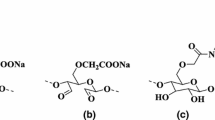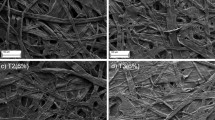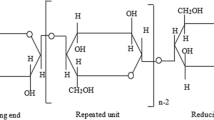A natural polymeric material, cellulose nanofibrils (CNFs), that can replace structural additives made of synthetic polymers was studied and characterized. The use of CNFs as a structural additive and the effect of adding them on the basic mechanical parameters of laboratory samples of packaging materials (corrugated sheet, i.e., the intermediate layer of corrugated cardboard) were studied. Addition of a structural additive made of natural renewable raw material to the recycled paper composite for corrugation was shown to increase the key paper quality indicators.
Similar content being viewed by others
Explore related subjects
Discover the latest articles, news and stories from top researchers in related subjects.Avoid common mistakes on your manuscript.
Cellulose is the most common renewable organic polymer and is used to fabricate cardboard, paper, cellophane, insulation, etc. The rapid development of the global pulp-and-paper industry has necessitated increased production efficiency by creating a new product line with improved consumer properties.
Natural cellulose is structurally organized on several hierarchical levels, with elementary fibrils as the simplest supramolecular structural elements. The phase state of natural cellulose is a linear, stereochemically regular, semi-crystalline polysaccharide with characteristic alternation of highly ordered crystalline and amorphous regions [1, 2].
The chemical properties of cellulose are determined by surface hydroxyls and glycoside bonds among elementary units. The glycoside bonds are susceptible to acid hydrolysis, which is utilized in nanocellulose production technology. Cellulose nanofibrils (CNFs) are produced by mechanical treatment of diluted (0.5-3%) aqueous dispersions of plant fibers, often in combination with chemical or enzymatic pretreatment stages. The degree of cellulose crystallinity is changed little by this. The aspect ratio of the obtained fibers is usually >10. CNF can be split longitudinally, tangled among themselves, or reticulated. As a rule, the fibers have a transverse cross section of 3-100 nm and are usually up to 100 pm in length [3, 4].
Currently, a new promising market segment in the pulp-and-paper industry is rapidly developing for specialized printing and packaging products and is gradually converting into a system for controlling paper quality indicators during both paper production itself and further processing of paper into finished products. CNFs are used to reduce the permeability of finished paper and to introduce organic and inorganic additives that are retained in the cellulose fiber matrix during drying. This also improves paper indicators such as formation quality, degree of retention of small fibers and filler particles, hardness, strength at break, compression resistance, layering resistance, and printing properties.
Considering these possible advantages, CNFs are considered a material with high potential for application in paper and cardboard production as an independent additive and as a replacement for other components [starch, sodium carboxymethylcellulose, poly(vinyl alcohol)] that improve the mechanical strength, printing properties, and paper surface modification with reduced raw material consumption [5, 6].
An analysis of the scientific and technical literature showed that the exact volumes of manufactured nano-sized cellulose and its industrial application to produce paper and cardboard at pulp-and-paper plants (PPPs) are unknown because of confidentiality. Also, laboratory, pilot, and production experiments found that total or partial replacement of water-soluble binders by CNFs could improve the quality and the rheological characteristics, reduce the cost of components, and conserve raw material and energy.
The goal of the present work was to study the effect of adding CNFs on the paper quality indicators, i.e., the ability to improve the mechanical properties of laboratory paper samples for corrugation (intermediate layer of cardboard).
The basic lignocellulose raw material for producing CNFs was sulfated whitened deciduous cellulose that had not been dried and was taken from the liquid processing stream of AO Arkhangelsk PPP.
CNFs were prepared by the literature method [7]. Raw material was loaded into a glass reactor with an acid solution (H2SO4, 50-55 wt.%). The acid hydrolysis temperature was 50-60°C; treatment time, 4 h. The reactor was equipped with an electric stirrer for constant mass and heat exchange. The reaction mixture from acid hydrolysis was unloaded from the reactor into a surge tank, filtered, and rinsed several times until the filtrate was neutral. The intermediate obtained after filtration and rinsing was mixed with H2O to a concentration of —1.5 wt.% of dry substance and suspended. The prepared suspension was pumped (peristaltic) into a mechanical treatment module consisting of a Hielscher UIP1000hd ultrasonic flow cell (power 1000 W; frequency 20 kHz) and a Masuko Supermasscolloider mill with disks rotating at 5,000 rpm. The intermediate underwent 3-4 mechanical treatment cycles.
The ζ-potential of the obtained hydrogel was recorded using electrophoretic light scattering and a Horiba SZ-100 spectrometer in a cuvette with graphite electrodes and automatic selection of the recording parameters. A suspension (1.5 wt.%) was diluted beforehand by 20-100 times.
The mass content of dry material in the samples was determined according to GOST 16932 using a gravimetric method based on determining the weight of dry material obtained after evaporation of the sample.
The length distribution of the CNFs was determined using an ANALYSETTE 22 MicroTec plus laser diffraction analyzer (Fritsch, Germany). The length measurement range was 0.08-2000 μm.
X-ray scattering by samples was analyzed on an ARL X'TRA powder diffractometer (Thermo Electron Corp., Switzerland). Diffraction patterns were recorded in transmission mode. Samples were pressed at 400 MPa in order to produce compact flat samples with the cellulose fragments oriented as much as possible in the samples. The degree of crystallinity of the cellulose samples was calculated from the ratio of the total peak area of crystalline reflections to the total area of the diffraction pattern [8].
Laboratory samples of paper for corrugation (intermediate layer of corrugated cardboard) of specific mass 125 ± 5 g/m2 were prepared from grade MS-5B pulp fiber (100%) with degree of pulp milling 34-38°SR. The paper glue additives were added in the order Empresol N cationic starch (0.6%), CNFs (0-20%), and Flowsize glue made of alkylketene dimers (200-0.2%).
Physicomechanical tests were performed according to GOST 13525.8, GOST 13525.1, GOST R ISO 3035, GOST 20683 (ISO 3037-94), and GOST 5626-97.
CNF samples were produced according to the developed procedure. The developed technology could produce CNF aqueous dispersions in 80-90% yields with 1.5-3.0% of dry substance. The obtained samples had ζ-potentials of 65 mV.
Figure 1 shows electron-microscope images of air-dried CNF hydrogel films from a Phenom G2 Pro scanning electron microscope (USA). The photomicrographs show that CNFs had nonuniform structures. Nanofibrils of transverse cross section <0 1 μm formed a reticulated network. Large microfibril fragments with large transverse cross sections of several tens of micrometers could be observed.
The length distributions of starting cellulose fibers and CNFs obtained from them were analyzed using an ANALYSETTE 22 MicroTec plus analyzer. Figure 2 shows the results.
Figure 2a shows that the obtained length distribution of starting cellulose was broad and exhibited three maxima corresponding to 35, 115, and 600 μm. The recorded maxima on the length distribution curve of CNFs had two peaks corresponding to 14.5 and 60 μm (Fig. 2b). CNFs contained ≥ 50 vol.% of fibers ≤ 14 5 μm in length and ≥ 90 vol.% of fibers ≤ 28.4 μm in length.
Figure 3 shows diffraction patterns of reprecipitated amorphous cellulose produced by the literature method [9] and CNFs. The x-ray diffraction patterns were typical of cellulose I with crystalline reflections and an amorphous phase. The mean crystallinity index calculated from peak areas [8] was 3.4% for reprecipitated cellulose and 32.6% for CNFs. The degree of crystallinity for CNFs produced by high-speed milling could decrease with increased number of passes. Therefore, it was an important indicator of the technological process and allowed the material properties and its behavior in composites to be predicted because the crystalline region had the greatest resistance to elongation and breakage [10].
Previously, addition of CNFs to a fiber mass with particles of the same structure, an enormous specific surface area, and increased reactivity formed stronger interactions among fibers and uniform paper and cardboard microstructures and reduced production losses [11].
The mechanical strength of the paper sheet depended on the H-bond forces arising as free hydroxyls on the cellulose surface came into contact. The magnitude of the forces depended on the number of free hydroxyls, which increased as the nanofiber specific surface area increased.
CNFs were selected as the reinforcing component in the work. The dependence of the effect of CNFs added to the recycled mass in amounts from 0 (control sample) to 20% on the quality indicators of laboratory samples of paper for corrugation (intermediate layer of corrugated cardboard) was studied.
Figure 4 shows the relative change of paper quality indicators as functions of concentration of CNFs added to the composite as compared to control samples (CNF consumption 0%).
The results showed that the basic mechanical strength parameters of paper for corrugation (intermediate layer of corrugated cardboard) improved if CNFs were added.
The specific break resistance after adding 5, 12, and 20% to the recycled composite mass increased by 12.7, 28, and 35%, respectively, because the conformational interaction between fibers increased and the paper structure compacted.
Paper made of ground cellulose unfractionated by fiber size is known to be mechanically more resistant to breakage and compression and denser than paper prepared from separate fractions of the same ground cellulose. Therefore, the increase of the absolute resistance to compression by 8, 26.2, and 29.2% with the selected amounts of CNF additives could be related to the distribution of fine reinforcing particles within the structure of larger fibers that shaped the composite with a uniform homogeneous microstructure and with increased retention of small fibers.
The resistance to end compression with 5, 12, and 20% CNFs added to the fiber mass increased by 15.2, 214, and 30%; the resistance to side compression, by 53, 17.1, and 203%, respectively. This could be due to formation within the composite of a rigid three-dimensional network formed by CNFs.
The bending strength with multiple bends increased by 186.9 and 1143% for 5 and 12% of added CNFs, which was the most of all mechanical strength parameters of the laboratory samples of paper for corrugation. As a rule, this parameter depended on the fiber length, strength, and flexibility and bonding strength between fibers. Paper consisting of long, strong, flexible, and strongly bound primary fibers had the greatest bending resistance. The fiber mass was a multicomponent system, in contrast to primary fiber intermediates, that was characterized by high polydispersion and nonuniform components with short fibers dominating and fewer long- and medium-length fibers. Therefore, this effect did not depend on the degree of fiber processing (fiber length) but was determined by the nature of the CNFs. The noticeable increase of fiber flexibility could be useful in construction (multi-layered) items and also compensated partially for possible reduction of the base mass.
The results agreed with those previously obtained for the effect of CNF additives on the quality indicators for preparation of silicic-acid gels, wood sheets, and paper for corrugation that were made of fibrous raw material taken from processing streams of operating plants [12,13,14].
The results provided a better understanding of the structural and mechanical properties of paper during its production and established general rules for selecting components, processing parameters, equipment, and starting raw material in order to control the quality of the final product and to produce new nanostructured products with given mechanical properties using inexpensive types of raw material.
References
Z. A. Rogovin, Cellulose Chemistry [in Russian], Khimiya, Moscow, 1972.
L. S. Gal’braikh, Cellulose and Its Derivatives [in Russian], Khimiya, Moscow, 1996.
ISO/TS 20477.
H. A. Khalil, Y. Davoudpour, M. N. Islam, et al., Carbohydr. Polym., 99, 649-665 (2014).
S. H. Osong, S. Norgren, and P. Engstrand, Cellulose, 23, No. 1, 93-123 (2016).
F. W. Brodin, O. W. Gregersen, and K. Syverud, Nord. Pulp Pap. Res. J., 29, No. 1, 156-166 (2014).
A. A. Novikov, B. M. Anikushin, D. A. Petrova, et al., Chem. Technol. Fuels Oils, 54, No. 5, 564-568 (2018).
N. Terinte, R. Ibbett, and K. C. Schuster, Lenzinger Ber, 89, No. 1, 118 (2011).
M. S. Kotelev, Z. V. Bobyleva, I. A. Tiunov, et al., Chem. Technol. Fuels Oils, 53, No. 5, 722-726 (2017).
S. Iwamoto, K. Abe, and H. Yano, Biomacromolecules, 9, No 3, 1022-1026 (2008).
S. Boufi, I. Gonzalez, M. Delgado-Aguilar, et al., Carbohydr. Polym., 154, 151-166 (2016).
V. Vinokurov, A. Novikov, V. Rodnova, et al., Polymers, 11, No. 5, 919 (2019).
I. V. Voskoboinikov, S. A. Konstantinova, A. N. Korotkov, et al., Khim. Rastit. Syr 'ya, No. 3, 43-46 (2011).
I. V. Voskoboinikov, V. A. Kondratyuk, S. N. Nikol’skii, et al., Lesn. Vestn., No. 8, 110-116 (2012).
Acknowledgments
The work was performed in the framework of FTP Research and Development in Priority Directions of the Russian Science and Technology Complex for 2014-2020 with financial support from the Ministry of Education and Science of Russia (unique identifier PNIER RFMEFI57717X0265). We thank staff members of OAO TsNIIB (Pravdinskii) N. V Saran, E. V Lepeshkina, and E. M Tovstoshkurov for discussing scientific and procedural aspects of the experiments; AO Solikamskbumprom (Solikamsk) for consultation; and staff members of AO Arkhangelsk Pulp-and-Paper Plant (Novodvinsk) for supplying samples of technical cellulose.
Author information
Authors and Affiliations
Corresponding author
Additional information
Translated from Khimiya i Tekhnologiya ropily i Masel, No. 5, pp. 38 — 42, September — October, 2019.
Rights and permissions
About this article
Cite this article
Konstantinova, S.A., Semkina, L.I., Anikushin, B.M. et al. Natural Polymer Additives for Strengthening Packaging Materials. Chem Technol Fuels Oils 55, 561–567 (2019). https://doi.org/10.1007/s10553-019-01067-9
Published:
Issue Date:
DOI: https://doi.org/10.1007/s10553-019-01067-9








